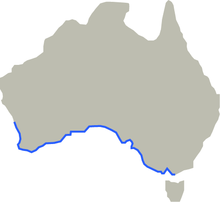| Leafy seadragon | |
|---|---|

| |
| Off Kangaroo Island, Australia | |
| Scientific classification | |
| Domain: | Eukaryota |
| Kingdom: | Animalia |
| Phylum: | Chordata |
| Class: | Actinopterygii |
| Order: | Syngnathiformes |
| Family: | Syngnathidae |
| Subfamily: | Syngnathinae |
| Genus: | Phycodurus T. N. Gill, 1896 |
| Species: | P. eques
|
| Binomial name | |
| Phycodurus eques (Günther, 1865)
| |

| |
| Phycodurus eques range | |
| Synonyms | |
| |
The leafy seadragon (Phycodurus eques) or Glauert's seadragon, is a marine fish. It is the only member of the genus Phycodurus in the family Syngnathidae, which includes seadragons, pipefish, and seahorses.[2]

It is found along the southern and western coasts of Australia. The name is derived from their appearance, with long leaf-like protrusions coming from all over the body. These protrusions are not used for propulsion; they serve only as camouflage. The leafy seadragon propels itself utilizing a pectoral fin on the ridge of its neck and a dorsal fin on its back closer to the tail end. These small fins are almost completely transparent and difficult to see as they undulate minutely to move the creature sedately through the water, completing the illusion of floating seaweed.
Popularly known as "leafies", they are the marine emblem of the state of South Australia and a focus for local marine conservation.[3][4]
- ^ Pollom, R. (2017). "Phycodurus eques". IUCN Red List of Threatened Species. 2017: e.T17096A67622420. doi:10.2305/IUCN.UK.2017-2.RLTS.T17096A67622420.en. Retrieved 19 November 2021.
- ^ Gomon, Martin F.; Bray, Dianne J. (n.d.). "Phycodurus". Fishes of Australia. Museums Victoria. Retrieved 8 November 2022.
- ^ "The Leafy Sea Dragon" (PDF). Yankalilla Visitor Information Centre. Archived from the original (PDF) on 9 May 2013. Retrieved 17 August 2011.
- ^ "Animals: Leafy Sea Dragon". National Geographic. Archived from the original on 20 May 2011. Retrieved 9 December 2011.
